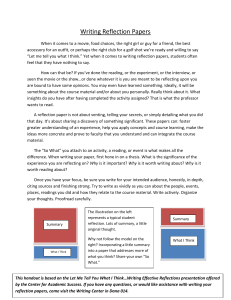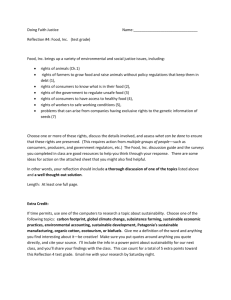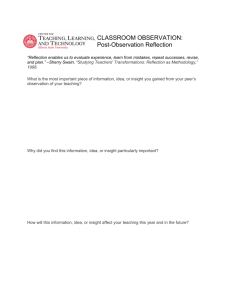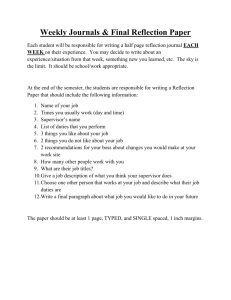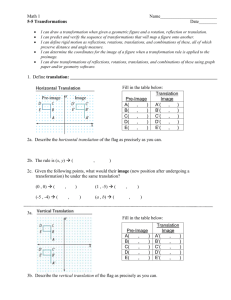Translations and Reflections Powerpoint
advertisement
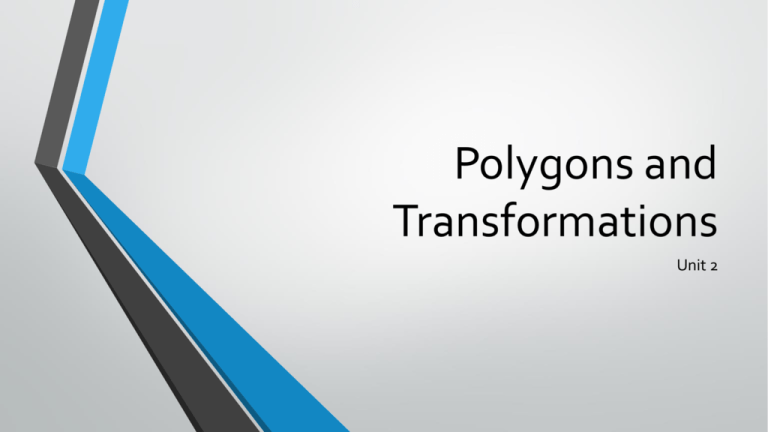
Polygons and Transformations Unit 2 Essential Questions 1.) How can you change a figure’s position without changing its size and shape? 2.) What process is used to perform a reflection across a line? What are Transformations? (Ch. 9.1) Definition: Characteristics and Tendencies: The methodical movement of a geometric figure on a plane. The starting figure is called a “pre-image” and the resulting figure is called an “image”. • There are 4 types: Translation, Rotation, Reflection, and Dilation. • Follows the same naming/labeling rules used with ≅ figures • Translation, Rotation, and Reflection • are called the Rigid • Transformations. Example: ∆ABC → ∆A’B’C’ Transformations Non-Examples: ABCD → A’C’B’D’ A Foldable for your Journal X-Axis Left and Right The Top Flap II I (-,+) (+,+) III (-,-) IV (+,-) - + Y-Axis Down and Up - + Coordinates (x,y) Pre-Image → Image A → A’ Original → Result Before → After Problem 3 (pg 547) T<-2,-5> (∆PQR) Item Being Affected Translation Change of X Value Change of Y Value Could Also be represented as: (x-2, y-5) Left 2 and Down 5 Inside the top flap Summarize what is happening to the transformation in your own words! What are Reflections? (Ch. 9.2) • • • • • • A reflection over a line k is a transformation in which each point of the original figure (preimage) has an image that is the same distance from the line of reflection as the original point but is on the opposite side of the line. Remember that a reflection is a flip. When reflecting over the x axis, the sign of y changes When reflecting over the y axis, the sign of x changes The notation for reflections: rk The image keeps the same dimensions as the preimage Lets take a look at an example 1.) Look at this problem and let’s go over it! (remember to put this cutout in your journal, not in your foldable) Ry-axis( ABC) The line you are reflecting over The item being affected Reflection X Y New X New Y A -3 4 A’ 3 4 B 0 1 B’ 0 1 C 4 2 C’ -4 2 Since we’re reflecting over the y-axis, only the X’s are affected Now let’s go back to our foldable…. On the Inside of the 2nd flap Summary: Vertical or Horizontal Axis: Count from each vertex of the pre-image to the axis of reflection and then count the same value again. y=x OR y=-x Switch the x and y values for each vertex in the pre-image. BOTH versions result in points that are equidistant from the axis of reflection. On the Front of the Third Page From Pg 557 in Textbook R y-axis (∆FGH) Reflection R y=-1 (∆FGH) R y=x (∆FGH) Figure Effected Axis of Reflection G’ (2,2) H’ G G (-3,4) H’ F H’ F’ F’ G G’ (2,2) (-2,-1) F F H H G’ Reflection (Flip) F’ (-1,-2) (4,-3) H Inside the top flap Summarize in your own words how to reflect an object! Now Let’s Practice! On the Back of the Third Page Summary: Based on the required rotation to each vertex, determine the resulting Quadrant, switch the x and y values if necessary, and then apply the – and + values as appropriate. On the Front of the Fourth Page From Pg 565 in Textbook Quadrants II (-,+) III (-,-) I (+,+) IV (+,-) 0˚=(x,y) 90˚=(y,x) 180˚=(x,y) 270˚=(y,x) 360˚=(x,y) r (90˚, O) (∆FGH) Figure Effected Rotation Degree of Rotation Center of Rotation (in this case it is origin) J’ F J G H’ F’ Counter – Clockwise Positive Rotation Every Quadrant is a total of 90˚ Clockwise Negative Rotation Rotation (Flip) G’ H
